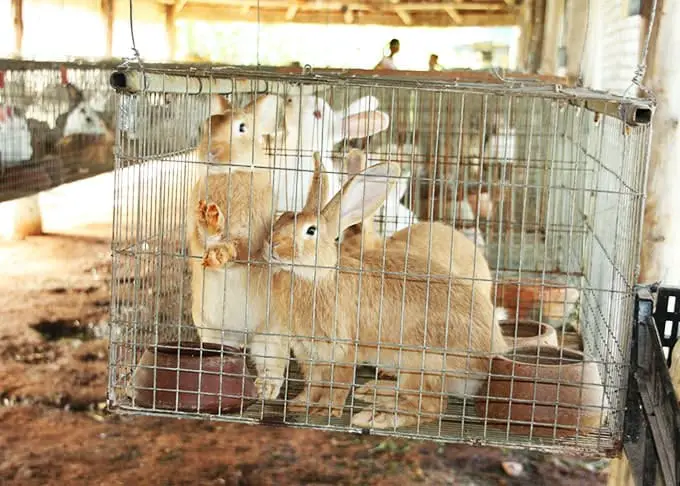Overview of Rabbit Farming and Management
Rabbit farming or breeding is a good foreign exchange earner. The meat and other related products are gaining popularity within and outside Nigeria. Dieticians have confirmed that the white meat, which is a source of animal protein, is of low cholesterol quality that is much needed by sufferers of HYPERTENSION and HIGH BLLOD PRESSURE.
This has made the meat to be in high demand among the elite who know its value. In addition, the meat is in high demand and is eaten all over the world for its delicacy.
Rabbits are highly prolific with a high feed conversion efficiency that gives them a for the rabbits very high economic importance. Being herbivorous, the animal is simple to manage and does not eat much food.
It depends on tender grasses, herbs, shrubs and edible vegetables. All these make the rabbits relatively cheap to breed.
Marketing potentials and benefits
The market for the rabbits and its by-products exist within and outside Nigeria; therefore, you do not need to worry about how to sell the products, which are as follow:
- Meat-a source of protein in our meals
- Skin-for leather shoe and bag-making industries
- Furs-for clothes manufacturing companies
- Blood-blood meals for livestock feed industries
- Bone-bone meals for livestock feed production
- Live rabbits – mostly demanded for family consumption, for research and experimental purposes by institutions of higher learning – universities, polytechnics colleges of education, research institutes, etc.
- Droppings – serve as manure for arable farming
Rabbits are scarce in commercial quantities; therefore, they tend to be expensive, selling from between one thousand naira (N1000) to two thousand naira (N2000) each. Rabbits are sold
SMALL SCALE RABBIT BREEDING

Some basic factors have to be considered in order to achieve success in small scale commercial rabbit breeding.
You must create awareness among individuals, restaurants, hotels, eateries, etc. (locally and internationally) through handbills, fliers, seminars, etc. this helps people realize the nutritional value and economic importance of rabbit meat.
VIABILITY/PROFITABILITY
Rabbit breeding is more lucrative than most people realize.
COMPETITION
Because of the low awareness of the profitability of rabbit breeding, there is limited competition in the business. In the event of eventual competition, the business is viable and elastic enough to accommodate it.
RAW MATERIALS
These include rabbits and other materials like feeds, concentrates, breeding cages, etc. a potential investor in this business must know where and how these could be readily and cheaply obtained.
COST/EXPENSES
Although rabbit breeding is quite inexpensive, one still needs to do one’s best to minimize cost in any way in order to maximize profit.
PRODUCTION PLAN/LOGISTICS
Making the product consistently available requires good manufacturing practice (G.M.P), as applies to most livestock products.
PRODUCTION
Rabbits are highly prolific and deliver from 6 to 10 young ones during each production cycle. The animal runs a pregnancy period of about 31 days and ahs the capability for pro-cycle seven times in a year.
After mating, the doe (the male rabbit) and the female one (the duck) must be kept in separate houses. It is not advisable for the male and female rabbits to be kept together, except for the time they are mating.
FEEDING
Rabbits should be fed twice daily with either compounded feed or grasses; alternating their livestock feed with grasses is good and will assist in their growth. The compounded feed should be weighed on a scale so as to determine their daily consumption and avoid feed wastage. Clean drinking water should be provided for them in their specially made containers, 24 hours of the day.
Rabbits drink more water in the dry season than in the rainy season. Apart from elephant grass, tridax, potato, leaves, etc. they eat edible vegetable grasses, shrubs, and herbs.
HOUSING

Rabbits should be kept either in cages or in hutches that are specially built for them in such a way that they are protected from rainfall and direct sunlight.
The cages must be on a stand inside a house purposely built for them. It is important that their houses should give room for future expansion of the farm. Rabbits are quiet and gentle animals that make little or no noise in their house.
SET-UP COST OF THE FARM
It is important for the farmer to raise funds to establish the farm. (if he has not been saving for the project, he can refer to chapter four of this guide for a comprehensive means of raising funds.)
COST
- Renting uncompleted fenced house in Lagos and Abuja for a year(This cheaper in other states.) N50,000.00
- Cages and other equipment N14,500.00
3 Rabbits breeding stock: →N15,000.00 20 female +5male@#600 each
4 General expenses, including Transportation and consultancy service N20,000.00
Total N99,500.00
The numbers of ducks and does you start with determine the total number of rabbits you have at the end of about six months, and consequently determine the level of profit your make – i.e the higher the number of stock you have for breeding the higher the level of your profit.
Since one doe can give birth to many young ones, it therefore means that you can actually become a millionaire between 6-12 months with a small capital of less than N100,000.00.






